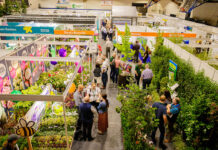
Replacing named potato varieties with newer varieties was not straightforward, according to Paul Coleman, technical director of Greenvale AP.
“Growers need to look for varieties that can produce yields, yes, but also consistent quality. There is no point growing a high-yielding variety that no one wants, or produces high yields on four out of five fields, but is riddled with disease in the fifth.

Replacing named potato varieties with newer varieties was not straightforward, according to Paul Coleman, technical director of Greenvale AP.
“Growers need to look for varieties that can produce yields, yes, but also consistent quality. There is no point growing a high-yielding variety that no one wants, or produces high yields on four out of five fields, but is riddled with disease in the fifth.
“And, unfortunately, there is no such thing as a variety without an Achilles’ heel. Most growers know how to manage older varieties for consistent production, and don’t want the risk of a new variety.”
However, in some situations, economics had driven variety replacement, he said. “For example, in Herefordshire, many growers were feeling it growing Estima at 16t/acre, when there were not the premiums available to do that.”
Newer varieties, such as Sylvana, had begun to replace it in the region with yield increases of 2-3t/acre, he said. “So, yes, variety is one way of increasing yield, and reducing costs of production, but there are other things growers could look at.
“For example, I think there is still not enough emphasis on getting seed rates right. Cambridge University Farm has done a lot of research on seed rates, and using them to achieve the right ware size and distribution, yet, still growers are using a wide range of seed rates.
“And there is chronological ageing of seed on top, which can make a big difference to saleable yield. Changing the chronological age of a seed lot by a month can alter stem and tuber numbers by up to 30%. But too many growers are ignoring that, and not planting 30% more or less seed, which would help maximise saleable yield.”
New irrigation technology could also have a big impact on yield, he said. “We’ve invested heavily in trickle and sprinkler irrigation on premium varieties, such as Maris Piper. “It is having a significant impact on biological, as well as saleable yield. It is having a big payback, albeit on a significant investment.”
Drip irrigation was also producing excellent results across a range of crops for Produce World, who grow 120ha of potatoes using that method, as well as some brassicas and carrots.
“We’re achieving the same yields with 40% less water,” Simon Bowen, the firm’s agronomy director said. “In addition, we are getting more consistent quality, with around 10-15% better pack out.”
In future, the firm would like all its Maris Piper produced using drip irrigation, with the advantages of better common scab control, and because drip irrigation keeps the foliage dry, a reduced blight and blackleg risk.
“Drip irrigation can also be used for delivery of nutrition, and biocontrol agenst, such as Nemaslug for potato cyst nematode control,” Dr Bowen said. “And because you can use it to treat different parts of the field, you can focus applications on areas that require treatment. It is a really powerful way of managing crops.”
The technique wasn’t appropriate for all soil types, Andrew Burgess, Produce World’s director of agriculture, said. “You need a soil with a degree of water retention, which makes it difficult on very light soils.”
But if a significant number of growers adopted the technique, water savings could be huge, Dr Bowen concluded.
Sector prices
Over-production of potatoes was one of the key reasons for lower prices in the sector, Paul Coleman, technical director of Greenvale AP, said.
Price pressure was occurring at the retail end because of the current economic situation, and creating a challenging marketplace. “But there is still too much potato production in UK and Europe, which is putting growers in a weak negotiating position.”
Potato area hadn’t increased too much this season, he admitted, but large yields in the south had pushed potato production over 6m tonnes.
Source: Farmers Weekly Interactive – British Potato 2011: Use Technology to Boost Yields






